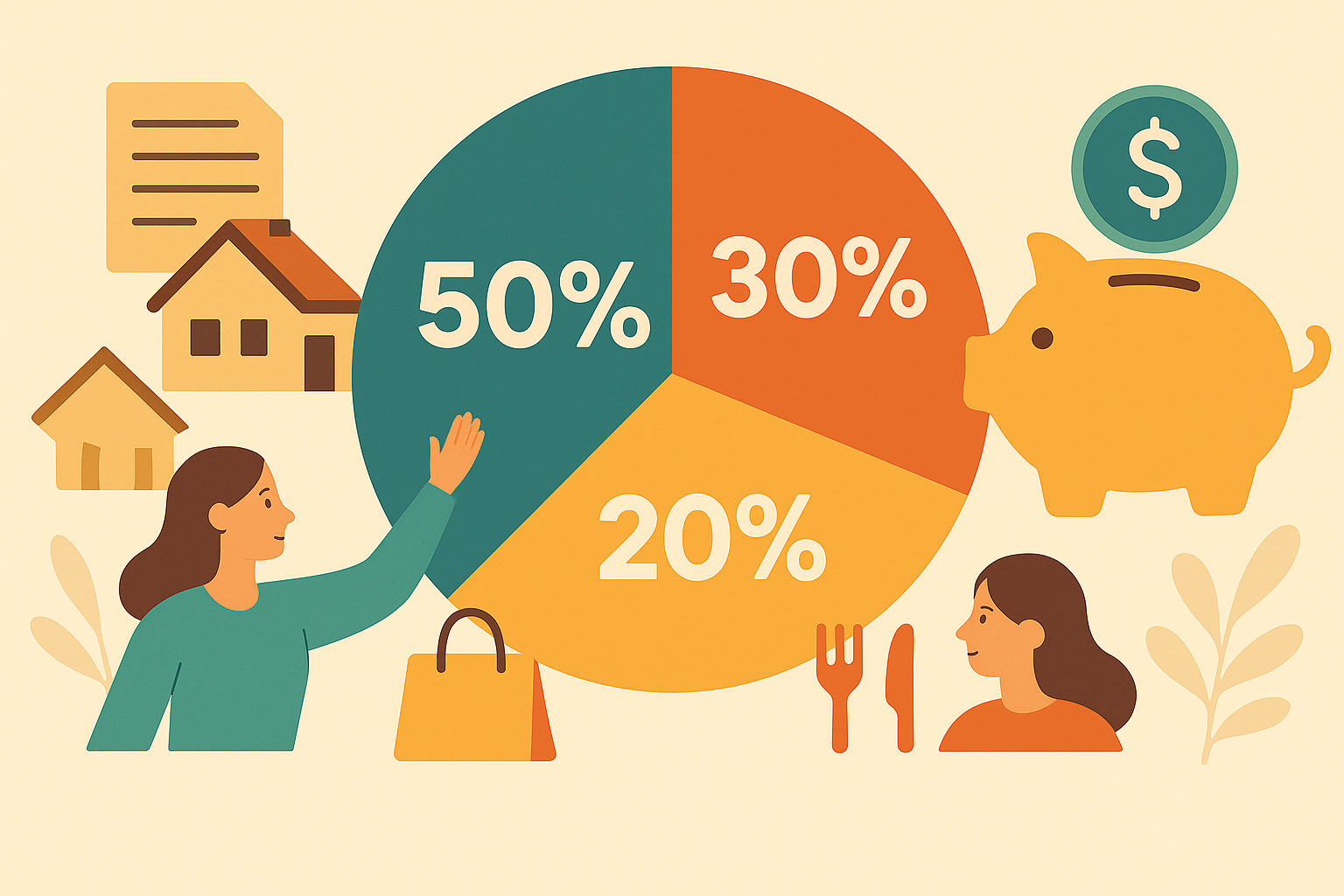Hey there, friend! Let me tell you about the day I discovered the 50-30-20 rule and how it completely changed my relationship with money. I was sitting at my kitchen table at 11 PM, surrounded by receipts and a calculator that was definitely judging my life choices.
I’d just spent two hours trying to categorize every single expense from the past month. Did that $10 smoothie count as food or entertainment? What about the phone charger I bought at the gas station – was that technology or emergency expenses? By the time I got to debating whether my Netflix subscription was entertainment or utilities (it’s basically a utility at this point, right?), I wanted to throw my laptop out the window.
That’s when I stumbled across something called the 50-30-20 rule during a late-night Google spiral. The article claimed it would take “about ten minutes” to set up.
Ten minutes? I’d been drowning in budgeting spreadsheets for months, and this was supposed to be the answer? Naturally, I was skeptical as hell.
However, I decided to give it a shot anyway. Turns out, the 50-30-20 rule became the financial game-changer that finally made budgeting click for me. No more 47 different expense categories, no more analyzing every coffee purchase, no more budgeting-induced headaches.
In this post, I’ll walk you through exactly how this simple rule works, why it’s so effective, and how you can set it up for your own financial situation – even if math makes you break out in hives.
What Exactly Is the 50-30-20 Rule?
The 50-30-20 rule is stupidly simple, which is exactly why it works. Essentially, you take your after-tax income and split it into three buckets:
- 50% goes to needs (rent, groceries, utilities, insurance, minimum debt payments)
- 30% goes to wants (dining out, entertainment, shopping, hobbies, that expensive coffee habit)
- 20% goes to savings and extra debt payments (emergency fund, retirement, paying off credit cards faster)
That’s it. Three categories. No subcategories, no color-coding, no PhD in accounting required.
Moreover, the beauty is in its simplicity. Instead of tracking whether your morning latte counts as “beverages” or “breakfast,” you just know it comes out of your 30% wants bucket. Similarly, instead of creating separate line items for electric, gas, water, and internet, they all fall under your 50% needs category.
Why the 50-30-20 Rule Actually Works
I’ve tried a lot of budgeting methods. For instance, there’s the envelope system where you put cash in different envelopes (I lost half the envelopes). Then there’s zero-based budgeting where every dollar has a specific job (too rigid for my chaotic life). Additionally, I attempted the detailed spreadsheet approach where you track every penny.
Here’s why the 50-30-20 rule succeeded where others failed:
It’s flexible. Life happens. Sometimes you need to spend more on groceries because your friends are coming to town. Other times, you find an amazing deal on something you’ve been wanting. Fortunately, the 50-30-20 rule gives you wiggle room within each category without derailing your entire budget.
It’s realistic. Other budgeting methods assume you’ll never want to buy anything fun ever again. In contrast, the 50-30-20 rule actually builds fun money into your budget. As a result, you get 30% of your income to spend on whatever makes you happy, guilt-free.
It’s sustainable. You’re not constantly updating spreadsheets or carrying around envelopes of cash. Instead, you set it up once, automate what you can, and check in weekly or monthly.
It scales with your income. Whether you make $30,000 or $130,000, the percentages work. Consequently, as your income grows, all three categories grow proportionally.
Let’s Get Real: What This Looks Like with Actual Numbers
I’m going to walk you through exactly how this works with real numbers, because I know math anxiety is real and percentages can feel abstract.
Example 1: Take-home pay of $3,000/month
- Needs (50%): $1,500
- Wants (30%): $900
- Savings/debt (20%): $600
Example 2: Take-home pay of $4,500/month
- Needs (50%): $2,250
- Wants (30%): $1,350
- Savings/debt (20%): $900
Example 3: Take-home pay of $2,200/month
- Needs (50%): $1,100
- Wants (30%): $660
- Savings/debt (20%): $440
See how it scales? The actual dollar amounts change, but the system stays exactly the same.
Now, let me show you what goes in each category, because this is where people get confused.
Breaking Down the 50%: Your Needs (Not Your Wants in Disguise)
Your needs are expenses you literally cannot avoid. If you stopped paying for them, you’d be homeless, hungry, or unable to work. Here’s what actually counts:
Housing costs: Rent or mortgage, property taxes, basic utilities (electric, gas, water, trash), basic internet (not the premium package with 47 streaming channels)
Transportation: Car payment, gas, insurance, public transit passes, basic car maintenance
Food: Groceries and essential household items (toilet paper, cleaning supplies, etc.)
Insurance: Health, dental, vision, life insurance premiums
Minimum debt payments: Credit cards, student loans, any other debt minimums
Basic phone plan: You need a phone to work and function in society, but it doesn’t need to be the latest iPhone with unlimited everything
Here’s what doesn’t count as needs (I see you trying to justify that premium gym membership): streaming services, dining out, premium cable, expensive gym memberships, name-brand groceries when store brands exist, premium car insurance with every add-on known to humanity.
If your needs are eating up more than 50% of your income, you have a few options. First, you could increase your income. Alternatively, you might decrease your costs (get a roommate, move somewhere cheaper, switch to a basic phone plan). Finally, you could temporarily adjust the percentages while you get back on track.
The Fun 30%: Your Wants (Guilt-Free Zone)
This is where the 50-30-20 rule gets fun. That 30% is yours to spend on whatever makes you happy, no questions asked. Some examples include:
Entertainment: Movies, concerts, streaming services, books, video games, hobbies
Dining out: Restaurants, coffee shops, food delivery, happy hour drinks
Shopping: Clothes, gadgets, home decor, gifts, anything that’s not a basic necessity
Personal care: Fancy skincare, salon visits, massages, premium gym memberships
Travel: Weekend trips, vacations, flights to visit friends
Subscriptions: Spotify, Netflix, that meditation app you use twice a month but feel guilty canceling
The magic of having a designated fun money bucket is that you can spend it without guilt. Want to blow your entire wants budget on concert tickets? Go for it. On the other hand, if you prefer to spread it out over smaller purchases throughout the month, that works too.
However, the key is that once your wants money is gone for the month, you’re done until next month. This prevents the “death by a thousand small purchases” problem that kills most budgets.
The Future-You 20%: Savings and Extra Debt Payments
This 20% is where you build your financial freedom. It’s the money that buys you options and peace of mind. Here’s how to prioritize it:
Step 1: Build a starter emergency fund ($500-$1,000 to handle small emergencies without using credit cards)
Step 2: Get your full employer 401(k) match (this is free money – always take it)
Step 3: Pay off high-interest debt (credit cards, personal loans with rates above 6-7%)
Step 4: Build a full emergency fund (3-6 months of expenses)
Step 5: Increase retirement savings (aim for 15% total including employer match)
Step 6: Save for other goals (house down payment, vacation fund, car replacement fund)
Don’t try to do all of these at once. Instead, pick one, focus on it until it’s done, then move to the next. Remember, progress beats perfection every single time.
Setting Up Your 50-30-20 Budget (The Step-by-Step)
Okay, enough theory. Let’s actually set this up. Grab your phone, open your banking app, and let’s do this together.
Step 1: Calculate Your Monthly Take-Home Pay
First, look at your most recent pay stub. Then, take your after-tax amount and multiply it by how many times you get paid per month. If you’re paid bi-weekly, multiply by 2.17 (because some months have three paychecks). Alternatively, if you’re paid twice monthly, multiply by 2.
Step 2: Do the Math
Next, calculate your three budget categories:
- Take-home pay × 0.50 = Needs budget
- Take-home pay × 0.30 = Wants budget
- Take-home pay × 0.20 = Savings budget
After that, write these numbers down somewhere you’ll see them regularly.
Step 3: Set Up Automatic Transfers
The day after payday, automatically transfer your savings amount to a separate high-yield savings account. If you don’t see the money, you won’t spend it. Therefore, start with whatever 20% equals for you, even if it feels scary.
Step 4: Choose Your Tracking Method
You need some way to track your spending in each category. Here are your options:
- Mint or YNAB: Apps that connect to your bank and categorize automatically
- Your bank’s app: Most have spending trackers built in
- The envelope method: Three envelopes or separate checking accounts
- A simple notebook: Old school but effective
Pick one and commit to checking it weekly.
Step 5: Start Simple
Don’t try to optimize everything in month one. Instead, just focus on hitting those three percentages roughly. Eventually, you can refine as you go.
When the 50-30-20 Rule Doesn’t Work (And What to Do About It)
The 50-30-20 rule is flexible, but sometimes life happens and you need to adjust. Here are the most common situations and how to handle them:
Your needs are more than 50%: This happens if you live in an expensive city or have high debt payments. In this case, temporarily adjust to 60-20-20 or 70-15-15 while you work on reducing costs or increasing income. Ultimately, the goal is to get back to 50-30-20 eventually.
You have irregular income: Freelancers and commission-based workers, this one’s for you. In this situation, base your percentages on your lowest typical month, and treat higher-income months as bonuses that go toward savings and debt payments.
You’re in debt payoff mode: Temporarily adjust to 50-20-30, putting that extra 10% toward debt. Once you’re debt-free, move back to the standard split.
You’re saving for a big goal: Planning to buy a house or start a business? Temporarily adjust to 50-20-30, with the extra 10% going toward your specific goal.
Nevertheless, the key is that these are temporary adjustments. The 50-30-20 rule is your home base to return to.
Common Mistakes to Avoid (Learn from My Fails)
Mistake 1: Being too rigid the first month. I tried to hit the percentages exactly and stressed when I was $50 over in one category. Instead, give yourself grace while you’re learning.
Mistake 2: Miscategorizing wants as needs. That premium gym membership is not a need, no matter how much you love SoulCycle. Therefore, be honest with yourself.
Mistake 3: Not automating savings. The first few months, I kept my savings money in checking and spent it. To avoid this, automate the transfer so you’re not tempted.
Mistake 4: Forgetting about irregular expenses. Car registration, holiday gifts, annual subscriptions – build these into your monthly budget so they don’t derail you.
Mistake 5: Comparing your budget to others. Your friend might spend 40% on wants because they live with roommates and bike to work. Remember, your situation is different, and that’s okay.
The Bottom Line: Simple Beats Perfect Every Time
After three years of using the 50-30-20 rule, here’s what I know for sure: the best budget is the one you’ll actually stick to. Moreover, the one you’ll stick to is the one that’s simple enough to understand and flexible enough to handle real life.
You don’t need 47 expense categories. You don’t need to track every dollar. You don’t need complicated spreadsheets or expensive software.
In fact, you just need three numbers: 50, 30, and 20.
Your future financially-stable self is counting on the decision you make right now. Therefore, ask yourself: Are you going to keep doing the same thing and hoping for different results, or are you going to try something that actually works?
The choice is yours. Your money is waiting.
Have you tried the 50-30-20 rule before? What’s your biggest challenge with budgeting? Drop a comment below – I love helping fellow money-learners figure this stuff out!






